That Fit Friend is supported by its readers. I [Jake Boly] run this site myself and buy the gear I review. If you purchase through my site, I may earn commissions on sales, read more here!
Van versus Converse is a battle that has been raging on in gyms for decades and continues into 2024. Both of these shoes are tried and true classics for casual wear, streetwear, and lifting.
More than likely you’ve seen lifters wearing Vans and Converse at the gym. Vans and Converse aren’t designed for lifting, however, their 0mm heel-to-toe drops and firm midsole make them prime contenders for supporting heavy-weight training, especially big deadlifts.
As someone who loves both Vans and Converse for casual wear and lifting, I wanted to put together an article discussing the differences between these shoes to help you decide which shoe to buy.
For most beginner and intermediate lifters, Vans and Converse will work well for most strength training contexts. I wouldn’t overthink which is “optimal” if you fall into this category.
I’ve squatted over 400 lbs and deadlifted over 500 lbs in Vans and Converse and they’ve been great for stability, so for these populations, their stability will work well.
My Favorite Vans and Converse Picks
- Best Pick for Powerlifting: Converse Chuck Taylor All-Star
- Favorite Pick for Squats: Vans Authentic
- Favorite Pick for Deadlifts: Converse Chuck Taylor All-Star
- Top Pick for General Strength: Vans Sk8-Hi
Want flat shoe options for training outside of Vans and Converse? Check out some of my favorite flat shoes for lifting. I built this list to cover a range of performance categories.
Why Trust My Vans Vs Converse Breakdown
For context, I’m a powerlifter who regularly trains in both shoes. I’ve deadlifted well over 500 lbs in each model and have competed in powerlifting in both shoes. I have a well-rounded idea of their performance in lifting settings.
I’ve also been a strength coach for over 10 years and regularly help athletes navigate if Vans and Converse are good shoes for their training needs. I assess this based on what they’re doing and the biomechanics that come with how each shoe influences movement.
If you’re deciding between Vans and Converse Chuck Taylor All-Stars, this article should hopefully help you make the best decision for your training needs.
Vans Vs Converse Similarities
When it comes to the question of which is better regarding Vans versus Converse, there isn’t a definitive one-size-fits-all answer.
Instead, I think it’s more productive to identify the similarities and differences between Vans versus Converse so you can select the shoe that is better for your individual wants and needs.
Similarity 1: Both Are Zero-Drop Shoes
The first similarity between Vans and Converse is that both deliver a 0mm heel-to-toe drop. If you’ve ever heard anyone refer to Vans and Converse as zero-drop shoes, then this means that they deliver a 0mm heel-to-toe drop.
When a shoe has a 0mm heel-to-toe drop this means that there is no difference between the height of the forefoot and heel in the shoe. Both of these shoes will have your feet sitting in a relatively flat position when training and wearing casually.
On top of being zero-drop shoes, most Converse and Vans have similar stack heights which typically sit around an inch in height. This can influence their performance in the gym, which I’ll add context on below.
Similarity 2: Both Have Rubber Outsoles (for the most part)
Another similarity is that Vans and Converse shoes both utilize rubber soles as their main means for delivering their fit, traction and feel. The soles of the core Vans and Converse models have remained relatively unchanged over the last couple of decades.
However, it’s worth noting that under the thin rubber layer on Converse’s outsoles, they’re made with a felt-like material. This is to save on import costs which is a fun fact that most don’t know.
For this reason, you can have Converse lose their grip faster in the context of long-term use which can impact their gym performance, and I’ll speak on this more below.
Similarity 3: Similar(ish) Upper Constructions
On top of similar sole constructions, the Vans and Converse models referenced in this article also have relatively similar upper constructions. For example, generally, you can expect canvas uppers with double-stitching in the core of Vans and Converse shoes.
Despite using similar materials to an extent, there is a bit of a difference in each shoe’s upper structure so this is not to say that their upper are identical in every aspect.
Similarity 4: Consistent Price Points
The final similarity that is worth noting about Vans and Converse is that their price points are all somewhat similar. Generally, for the Vans Authentic, Classic, and Sk8-Hi, you can expect to pay between $50-70 USD.
For Converse Chuck Taylor All-Star low-top and high-top shoes, you can expect to pay between $55-65 USD. These price points are in reference to the standard models for each shoe and not special edition models or limited drop series.
Vans and Converse Differences
Despite having some similarities, Vans and Converse vary in many ways. As you get more specific with your shoe asks these differences can matter more.
Difference 1: Branding and Appearance
The first core difference between Vans and Converse is the branding of each shoe. The branding of each shoe will change based on the model you go with.
Converse Chuck Taylor All-Star High-Top models have the classic Converse patch, while the low-top has minimal branding. This is similar to the Vans Sk8-Hi and Classic, which feature a prominent Vans stripe down the sides of the shoe, while the Authentic has minimal branding.
Difference 2: Outsole Construction and Tread
Another major difference between Vans and Converse is their outsole constructions and designs. The Vans models feature the signature rubber waffle outsole patterning while the Converse has a full rubber outsole with different tread patterns on the forefoot and heel.
On top of this, the Converse model’s rubber overlay can fade over time leaving you with a felt-like material. This feature is why Converse ships internationally as “slippers” and not shoes. It saves Converse costs but limits their long-term grip.
Difference 3: Insole Constructions
The insole construction for Vans and Converse is my final subtle difference between these shoes. Both models feature non-removable insoles, however, the Converse insole is a lot easier to remove.
If you’re someone with custom orthotics or insoles, then this could be an important point to consider when investing in these shoes. The Converse will be a better option for this context and the insoles can be tough to remove in some of the Vans models.
Takeaway Points
- The main Converse and Vans shoes have multiple construction similarities and price points.
- Both shoes deliver a somewhat similar fit and feel with their 0mm heel-to-toe drops and stack heights.
- The branding and outsole construction are both core differences between each model to consider.
Vans Vs Converse Gym Performance
To gather a full understanding of Vans and Converse in the gym, I’m going to break this performance section into a few key categories. I’ve worn and tested a variety of Vans and Converse for a variety of training sessions.
Vans Vs Converse for Powerlifting
Both Vans and Converse work for powerlifting and powerlifting-focused training and this is due to their 0mm heel-to-toe drop and firm midsole construction. For powerlifting, you need to excel in three exercises, the squat, bench press, and deadlift.
Vans and Converse’s zero-drop construction makes them great contenders for deadlifting specifically as they help provide a flat surface to pull from. A flat and firm outsole allows you to root the feet better and drive into the ground.
For beginner and intermediate powerlifters, I think Vans and Converse can both be good picks, especially if you’re just getting into powerlifting and you don’t want to spend on premium shoes or buy multiple shoes.
When competing in both shoes, I deadlifted over 500 lbs and squatted between 395-420 lbs and both shoes did a fairly good job regarding their performance.
I do think the Converse Chuck Taylor All-Star can perform a little better for powerlifting than most Vans models. I like that you can remove the insole in this model to get closer to the ground. This can make them marginally better for anyone training with maximal loads.
In addition, some Vans models have slightly higher stack heights compared to Converse Chuck Taylor All-Stars, so when breaking down granular differences, Converse has a slight edge when it comes to powerlifting.
- Winner: Converse from an “overall context”, but not by much. However, powerlifting is a game of inches and little details can matter. Read more about each shoe’s performance for squats and deadlifts below for some nuance.
Vans Vs Converse for Squatting
In the context of squatting, you can expect a similar performance from both shoes — for the most part. Their zero-drop construction can be great for low-bar squatters who have more hingey-y squats and anyone who has pretty good mobility.
That said, if you’re unsure if flat shoes are good for your squatting mechanics, then I’d suggest checking out my flat vs heel elevated shoes for squats article.
On top of their flat constructions, the stability will be similar in both Vans and Converse. The rubber and denser midsoles used in Vans and Converse don’t compress easily when squatting and have worked for my squats up to 420 lbs.
I think the main difference to consider between Vans and Converse is their outsole treads. The Vans waffle tread will last longer than the outsole build used in Converse models. If you’re worried about long-term grip and have squat goals, then you’ll want to consider this.
- Winner: Both work well, but Vans outsoles typically last longer giving you the most traction for squatting on different surfaces.
Vans Vs Converse for Deadlifts
When it comes to deadlifting, Vans and Converse can both be good picks from a zero-drop and stability point of view. These models have been used for years for deadlifts due to their stability and flat sole construction.
In both shoes, I’ve deadlifts over 500 lbs and they’ve been consistent. With that in mind, as you get more serious with your deadlift training I think there are two major construction features to consider.
First, the stack height of the Converse is a little lower than Vans. Since you can remove the insole in Converse easier, too, it can be a better option for those wanting to get closer to the ground.
As you work on 1-rep maxes and get more niche with your deadlift training subtle differences like this matter. You want to cut down on the total range of motion you need to deadlift. This is why you see lifters often deadlift barefoot or in barefoot shoes.
Second, you’ll want to consider the outsole tread on each shoe. This matters more for sumo deadlifts and powerlifters who will be competing on the carpet material most federations use.
If your Converse is losing its rubber tread then you’ll want to either buy a new pair for deadlifts or opt for a Vans to avoid running into this issue. For example, my tan Converse High-Top model featured in this article has been retired for this reason.
I do prefer Converse more than Vans for deadlifts, but this last tread aspect is something you’ll want to keep an eye on if you’re using your shoes a ton for lifting and daily wear.
- Winner: Converse due to their slightly lower stack height but please keep an eye on your shoe’s outsole. The last thing you want is your feet to slip out mid-deadlift.
Vans Vs Converse for General Strength Training
From a recreational lifting context, Vans and Converse are fairly neck and neck for me. The Converse Chuck Taylor All-Stars feature a canvas upper which is fairly durable across the board and will usually last a while before breakdown issues are experienced.
My Converse typically lasts 6-8 months before I notice any signs of their upper construction ripping or breaking down. I’ve had the outsole break down faster than the upper in most of my Converse shoes.
Most Vans models come with either a canvas, suede, or leather upper. Canvas uppers are most commonly used in Vans shoes in the gym. Most of my Vans last about 6-8 months before the upper stretches from lifting or the stitching starts to fray.
I will say, that if you do a lot of lunges and split squats and rock the Vans Authentic then you may run into upper durability issues faster. The canvas can pull away from this shoe’s sole at the toe box with a lot of harsh flexion.
As for stability, I think both of these models will perform fairly equally for the general lifter. The Vans do have a slightly more cushioned insole, but overall, I don’t think this will negatively impact the recreational lifter and may be more comfortable for regular wear.
- Winner: Tie. Both models have similar upper durability for recreational training and the Vans may be a more comfortable option overall. As you get more specific with your training that’s when their differences will matter more.
Vans Vs Converse Durability
When it comes to durability, it’s tough to select a true “all-the-time” winner between Vans and Converse.
Each model has very similar core construction features and neither of these shoes is technically designed for lifting-focused wear, so in this context, their durability can be slightly skewed compared to those who wear these models on a day-to-day basis.
The most common Vans and Converse models that are worn in the gym generally feature canvas uppers. Canvas is fairly durable daily, but in the gym, it can be prone to ripping and stretching.
If you’ve ever worn a pair of Converse for a while, then you’ve likely noticed how the medial upper material starts to collapse from constant stress and daily wear.
When squatting and deadlifting a lot of weight, the canvas that surrounds the boots of these shoes can be prone to stretching and ripping. I’ve had a pair of Converse rip at the boot and a pair of Vans start to rip around the upper part by the big toe.
In both of these cases, this was around the 8-month mark of religious wear with the shoes for lifting and daily wear. Durability can also vary greatly depending on your context so this is not always a one-size-fits-all topic.
- Winner: Tie. Both models tend to be super strong for about 6-8 months with tough gym use which makes sense when you consider their price point and that they’re not designed for the gym.
Vans Vs Converse Sizing
For performance and durability, both Vans and Converse are similar, however, for sizing this is not the case. If you’re buying these shoes for lifting and daily wear, then you’ll want to get the sizing right for comfort and performance purposes.
Before buying, I always suggest checking out what Vans and Converse say in their product details about sizing as this can also help you decide what size to go with.
Vans Sizing Thoughts
For the general pair of Vans, most should be safe going true to size. Most Vans fit fairly true with their length and typically have a medium width throughout the toe and mid-foot.
That being said, if you’re new to Vans, they may feel a little narrow through the mid-foot, so expect that when grabbing a pair. Generally, though, the canvas upper will stretch a bit and break in so this is usually not the biggest deal for most.
- Sizing Thoughts: Go true to size, but if you have a wider foot, then you may want to up a half size.
Converse Sizing Thoughts
Converse can be a pain to get right when it comes to sizing especially if you’re new to wearing them. For most folks, you’ll want to size down a half-size to a full-size. This will help you not feel like you’re swimming in the toe box, and you won’t look like you’re wearing clown shoes.
Converse can feel fairly slim through the mid-foot similar to Vans, but they do stretch out over time, so give them a few sessions and they’ll likely start to form and fit your foot a bit better.
- Sizing Thoughts: Size down a half to full-size. If you generally have a good amount of room in the toes in your normal shoes, then go a full size down.
Vans Vs Converse Buying Tips
Tip 1: Confirm Sizing From Multiple Reviews
When looking into different Vans and Converse shoes you’ll want to make sure you read user reviews and check out their sizing recommendations as sizing can differ from model to model.
For example, most will want to size down their Converse a half-size to full size while others with wider feet may want to size up their Vans a half-size to play it safe.
Tip 2: Cross-Reference Shoes With Your Performance
Vans and Converse are both zero-drop shoes that feature dense midsole constructions. This gives each model a fairly similar feel when training and wearing them casually.
As you get more specific and granular with your asks that’s when you’ll want to acknowledge the subtle differences between these shoes. If you have questions on which shoe to buy, please ask as I’ve reviewed countless Vans and Converse.
Vans Vs Converse Comfort
Overall, both of these shoes are okay from a comfort standpoint. They’re not going to be the most plush for long-duration wear due to their firmer outsole construction and low heel-to-toe drops, but they do okay.
Plus, over the last few years, Converse, which is now owned by Nike has had their insoles slightly reworked to provide a bit more responsiveness and comfort for longer-term wear.
Converse can be worn to run errands in and for lifting sessions and they’ll be decently comfortable. I would not recommend them for long walks or all-day wear though.
Similar to Converse, the Vans Authentic shoes have a decently responsive insole. In my opinion, the Vans insole is a bit more cushioned than the Converse, so they do have a slight edge for comfort. Still, though, I wouldn’t recommend wearing Vans for long-term wear or standing all day in.
- Winner: Tie. Both models are okay for shorter-duration wear and lifting but fall short for all-day wear.
Frequently Asked Questions (FAQ)
Q:Which is better Vans or Converse?
Q:Are Vans more popular than Converse?
Q:Is Vans more expensive than Converse?
Wrapping Up
The Vans versus Converse debate is a fun one to go back and forth on. Both are popular shoes for lifters everywhere. As “first” shoes for lifting, Vans and Converse can be great picks.
They’re both pretty similar regarding performance. If we want to get more granular and nuanced, then I do think the Converse Chuck Taylor All-Stars take a slight edge for strength training.
If you have any questions on these two models, please feel free to drop a comment below or reach out via Instagram (@that_fit_friend or @jake_boly)!

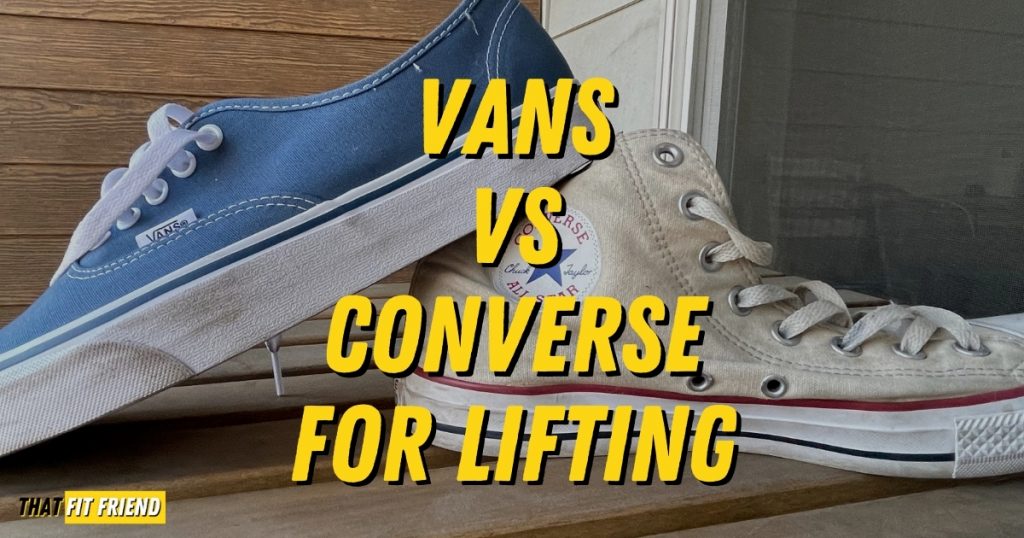
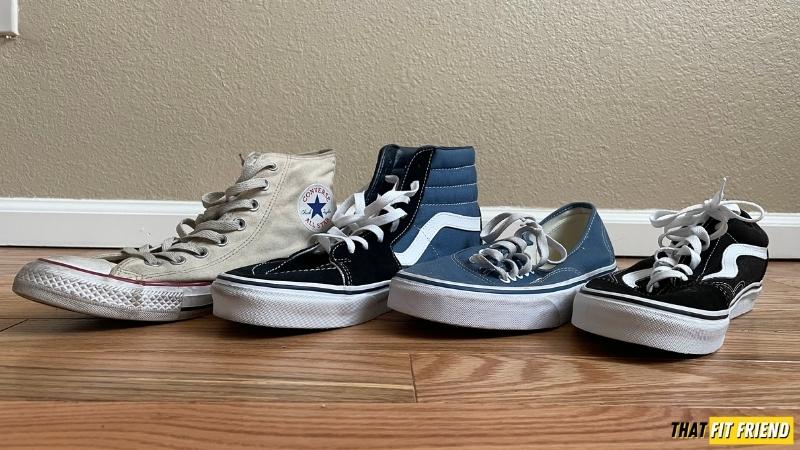

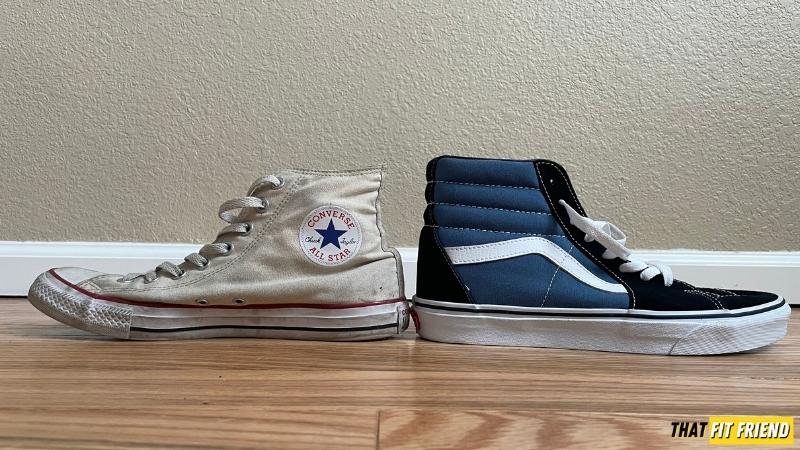

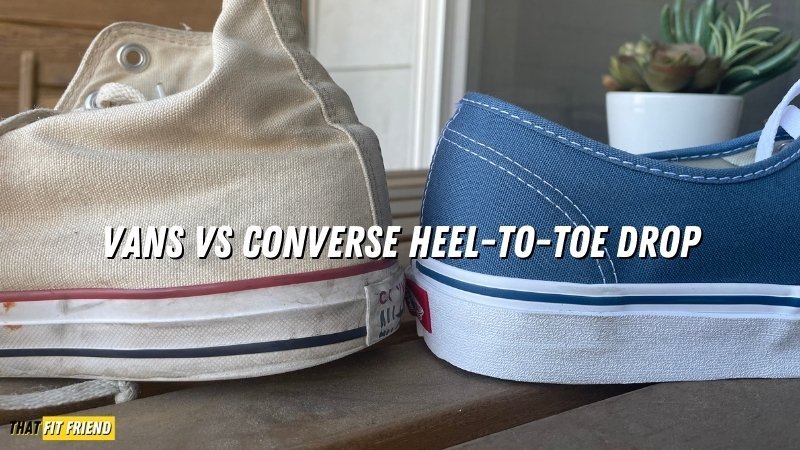











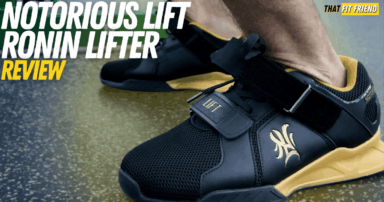



Charlie
Very helpful article, thanks Jake!
Stoked it helped out!